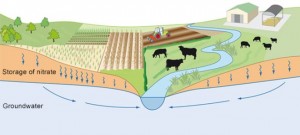Nitrates in Water: The Basics
The primary sources of nitrates in water are human sewage, livestock manure, and fertilizers. Areas with a high density of septic tanks and animal agriculture in close proximity to the drinking water source are most vulnerable to contamination by nitrates. Research has shown an increase in nitrates in water as both agriculture and population grows. While nitrates used to be a “well water” problem, many urban water suppliers now having to work to keep nitrate levels down. (See Nitrate Levels in Drinking Water Are on the Rise.)
The foremost health hazard associated with excessive levels of nitrates in water is blue baby syndrome, a condition that affects the blood usually in infants 6 months old or younger. Young infants’ digestive systems convert nitrates to nitrites and can be fatal.
Nitrates and nitrites are very soluble and cannot be precipitated from water. They are not removed by conventional filtration. This means they have to be treated with a chemical or biological process. The best residential treatments for nitrate contamination are reverse osmosis, distillation, and anion exchange. Reverse osmosis is normally the product of choice for residential applications. Anion exchange can also be effective but it is important to have a water analysis to show other contaminants. Anion treatment is less effective in water with high TDS, high hardness, and high sulfates.
EPA maximum contaminant levels (MCLs) are 10 mg/L for nitrate and 1 mg/L for Nitrite.





